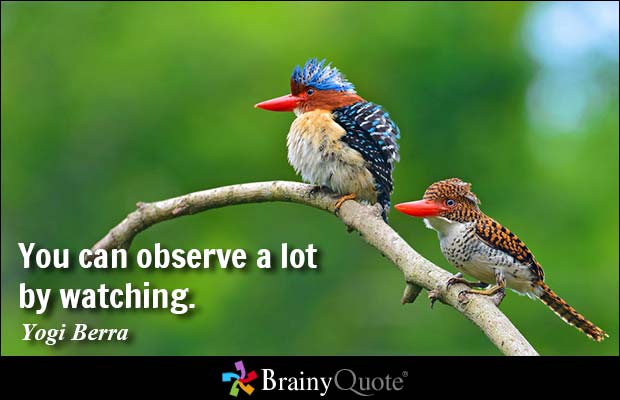I had the opportunity to work with a wonderful group of teacher leaders recently. As we were sharing our beliefs about learning, reading about some examples and discussing what it could and should look like everyone was excited and you could feel the passion in the room. Then, I asked the question that I knew would dampen the mood but was necessary to move forward- “When is the last time you observed one of your peers?” As expected (because this happens every time I ask this question), the room went silent as they looked around anxiously. They replied with a variety of responses: “never”, “it’s been a long time” or “we used to do that…”. One teacher shared about how she still relies on many strategies she learned from observing her amazing cooperating teacher 20 years ago. This is because observation is a powerful component of how we learn.

Despite the fact that researchers and teachers have linked observations of practitioners as some of the most effective professional learning, it is still rare for teachers to observe one another. I hear leaders argue that it takes time and money and scheduling etc…but I think one of the biggest barriers is that, more than anything, it’s uncomfortable and people are afraid. Teaching has long been an individual event behind closed doors and shifting that paradigm is not easy. It is not easy for teachers to open their doors to being observed, it’s uncomfortable for those observing and afraid of passing judgement on their peers, and it’s hard for administrators to push their teachers to do something out of their comfort zone.
But, in order to build capacity and develop a shared understanding of what powerful teaching and learning looks like, sounds like, and feels like, it is critical to observe (not just talk about) teaching and learning. Too often we make decisions based on assumptions, as well as our own beliefs and perspectives, rather that what is currently happening in classrooms.
Knowing how critical it is to see others teach and reflect on the implications for our own practice, I have continued to embed these opportunities in professional learning as I work with administrators and teachers. As far as professional development goes, despite popular belief, it is an inexpensive way in terms of both time and money and the impact on teachers is powerful. Once the teachers get the opportunity to see their peers teaching they often share the following key insights:
- Observations help ground the conversation about teaching and learning and allow for a much richer dialogue
- Observations prompt reflection about their own practice -both validating what they do and stretching their thinking
- Teachers want to their peers to experience the process- if you think about it, this shows a level of comfort with the process that they trust others to observe them knowing it will be about improving practice not judging them.
- In this new era of teaching and learning, especially with technology, teachers must see their colleagues teach to understand the possibilities in their own classroom.
So, here are a few ground rules that I have used to help make sure the observation process impacts teaching and learning:
Use a structured protocol- To ease the discomfort and guide the educators and make the most out of learning, I have modified the following protocol from the BERC Groups, STAR Protocol.
- Set clear indicators for observation: What are the 1-2 practices that you are looking for (i.e. problem of practice)
- Observe classrooms for 10 minutes each in groups of 2-4
- Debrief about what you saw and how it might impact your teaching- not about the teacher.
Focus on learning NOT evaluation: Ensure teachers understand that opening classrooms up to one another is a key step in school improvement and more about the observer, and the ensuing conversation, than it was about the teacher being observed. I have grown so much as an educator from the vast amount of amazing teachers I have observed and interacted with. To develop this culture in schools and among teachers is easier said than done and is often more successful with facilitation and clear protocols to help guide the process.
Never talk about specific teachers- To ensure that the observations and the debrief focuses on what was observed and implications for practice, not evaluating teachers, it is important to never talk about specific teachers. To impact learning, this should not be about evaluating the teacher because there are many nuances of the lesson that occur before you arrive and after you leave. This is about what you see in the time you are observing and what you can learn about the impact of the learning experience on students.
Observing learning should be a regular part of a teacher’s workday– To develop and share practice, observing learning must be part of the school culture- whether you call them learning walks or instructional rounds or whatever works for your site- observations should prompt questions, collaboration and new thinking that allow for teachers to gather and build on new ideas to spark creativity and innovation. Make sure you structure the debrief to guide observations and conversations to focus on learning and putting it into practice not creating a model where everyone believes they are expected to do the same thing:
- Determine instructional goals
- Ground the debrief in the key indicators that were being observed
- Talk about pedagogy, not teachers
- Provide specific examples- Continue to build shared understanding of what key indicators mean in real practices
- Determine next steps for systematic improvement
- Allow teachers to drive the next steps based on needs and context
Just do it, have fun and share what you are learning!


0 Comments
Trackbacks/Pingbacks